
The costs of climate change will far outweigh the costs of transitioning to a low-carbon economy, the European Central Bank (ECB) announced in a recent report. The green transition has driven a lot of talk about hydrogen (H2). Globally, a lot of countries and industries are increasingly betting on hydrogen to become part of their major decarbonization plans. Here are some of the global statistics as reported by the Economist:
In this article, we analyse the growing hydrogen market, and the challenges and opportunities it is facing.
These are some of the interesting facts about hydrogen and its possibility and limitations to becoming the new green fuel. Currently H2 is made from natural gas at a cost of more CO2 into the atmosphere. This is what we know about H2 so far:
Governments need to step up investment in H2 production and storage chains to help cut emissions to zero, the International Energy Agency (IEA). The Paris based organization provided these statistics and supporting evidence:
That is the big question on everyone’s lips. Well, certainly it can be part of the process bearing in mind that unlike electricity, there isn’t complete infrastructure for using hydrogen as an energy carrier which the IEA has also called for more investment in infrastructure. Surely, that is going to limit the speed of implementation. The sources of hydrogen are rather inefficient which will imply greater cost on production especially when competitiveness with forms of energy storage and transmission is the big ‘elephant’ in the room. Attaining net zero carbon with hydrogen from production processes that generate an equal amount of carbon is just relocating the carbon producing product to another location on planet earth. The splitting of hydrocarbons to get hydrogen is doable but it is very environmentally bad. Why? Simply because it uses energy to separate the molecular bonds that the remaining atoms end up being burnt for process energy or dumped releasing CO2, CO, C particulates amongst many others.
Hydrogen storage as H2 has a considerable weight penalty for transportation uses. New onshore H2 pipelines’ costs have been estimated at $2.2 – 4.5 million per km as of 2021. H2 transmission by pipeline is also loss, much more so than natural gas. The parasitic energy loss is approximately 1% per 100km up to 1000 km, dropping to 0.7% per 100 km as a length of 5000km is reached. Electricity via high-voltage, direct current (HVDC) is now below 0.3% loss per 100km, meaning that a much greater % of energy at the source reaches the destination when electricity is transmitted directly over long distances as such, rather than converting it to H2, transmitting it that way, then recovering it at the far end. Some analysts propose local renewable-to-electrolyzed green hydrogen energy in areas where HVDC can’t reach due to lack of infrastructure.
What is interesting to note is that, for almost the same number of projects reported by the Economist and IEA, the former projects 11 times more million tonnes of hydrogen supply per year by 2030 compared to the latter. The IEA goes on to state that only 50,000 tonnes of hydrogen will be produced in 2021.
So, we leave you with a follow up question; Is hydrogen a fossil fuel? If you can answer than then surely, you can respond to the initial question posed, Is hydrogen the new ‘green’ fuel.
Look forward to your answers and GRT always welcomes conversations that enhance knowledge and digs deeper into the science of the discussion.
Your feedback is important to us. If you enjoyed reading this Global Road Technology industry update and found it informative, please let us know by leaving a REVIEW.
References
Are environmental regulations, health and safety concerns or potential profit loss a concern right now?
Contact Us Now